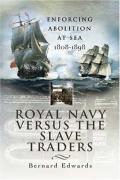On 16 March 1807, the British Parliament passed The Abolition of the Slave Trade Act. In the following year the Royal Navy's African Squadron was formed, its mission to stop and search ships at sea suspected of carrying slaves from Africa to the Americas and the Middle East. With typical thoroughness, the Royal Navy went further, and took the fight to the enemy, sailing boldly up uncharted rivers and creeks to attack the barracoons where the slaves were assembled ready for shipment. For much of its long campaign against the evil of slavery Britain's Navy fought alone and unrecognised. Its enemies were many and formidable. Ranged against it were the African chiefs, who sold their own people into slavery, the Arabs, who rode shotgun on the slave caravans to the coast, and the slave ships of the rest of the world, heavily armed, and prepared to do battle to protect their right to traffic in the forbidden black ivory. The war was long and bitter and the cost to the Royal Navy in ships and men heavy, but the result was worthy of the sacrifices made. The abolition of the slave trade led to a scramble for empires and, in place of slaves, Africa began to export cocoa, coffee, timber, palm oil, cotton and ores, all very much in demand in the West.
Royal Navy Versus the Slave Traders: Enforcing Abolition at Sea 1808-1898
- Details
- By: Bernard Edwards

- Title: Royal Navy Versus the Slave Traders: Enforcing Abolition at Sea 1808-1898
- First Published by: Pen & Sword Maritime
- First Published Format: HC
- First Published Date: 18 October 2007
- ISBN-10: 1844156338
- ISBN-13: 9781844156337